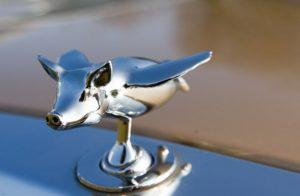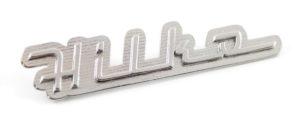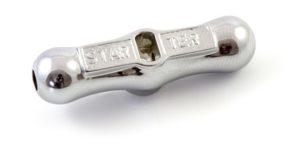 With an extensive lineup of 20 different materials and over 100 possible color and finish combinations, Belgium-based 3D printing company i.materialise has situated itself as one of the premier 3D printing service bureaus in the entire world. After rolling out a number of unique materials back in 2015, including their red gold plated brass and black color plated brass, i.materialise has stayed the course of material innovation. Last month, they unveiled their Smooth Detail Resin, a material capable of producing high resolution prints with 50 μm layers. Now, the service bureau is getting their shine back on, recently announcing the newest addition to their vast material family, Chrome-Plated Brass.
With an extensive lineup of 20 different materials and over 100 possible color and finish combinations, Belgium-based 3D printing company i.materialise has situated itself as one of the premier 3D printing service bureaus in the entire world. After rolling out a number of unique materials back in 2015, including their red gold plated brass and black color plated brass, i.materialise has stayed the course of material innovation. Last month, they unveiled their Smooth Detail Resin, a material capable of producing high resolution prints with 50 μm layers. Now, the service bureau is getting their shine back on, recently announcing the newest addition to their vast material family, Chrome-Plated Brass.
Currently available to order from i.materialise, the Chrome-Plated Brass has quite an intensive process to get from 3D design to the polished chrome finish. The technique begins with producing a wax 3D print, which is used to create a mold of the printed model. That 3D wax print is then burned out of the mold, while the cavities that are left behind are then filled with liquid brass. This brass-casted model is finished manually, coated first in a layer of copper, then nickel, which acts as an adhesive for the final layer of chromium.
By incorporating 3D printing, casting and electroplating into one process, i.materialise has created a true metal material option with a smooth surface, high-quality detail, and a boastful shine. Not only is surface finish of the Chrome-Plated Brass aesthetically pleasing, it also offers corrosion resistance and increased hardness to your model, making it an ideal material for decorative objects like car parts and tools. Still, there are some crucial design guidelines that i.materialise must provide to ensure a proper 3D printing with the Chrome-Plated Brass material.
For starters, the minimum wall thickness should be limited to 0.6 mm, while small decorative parts and engraved text should have a size of at least 0.35 mm. The build size limitation for submitted designs are restricted to up to 88 x 63 x 125 mm, and can not be grouped with other models or interlocking for this particular material. Finally, for hollow models, i.materialise suggests adding at least three release holes of at least 1.5mm to help rid the liquid brass from inside the model.
With the addition of the Chrome-Plated surface finish, i.materialise now has a total of five available surface finishes for their Brass, which also includes yellow gold-plated finish, clear PU coating, red gold-plated polished, and black color-plated polished. Although the Chrome-Plated Brass may seem like an ideal choice for 3D printing jewelry, i.materialise does not recommend using this particular material finish. Since the base layer of these chrome plated parts will contain nickel, some of the nickel coating could possibly be released and come into contact with the skin, which in some cases may cause inflammation.
i.materialise currently has three trial pieces printed in the Chrome-Plated Brass displayed on their website, including a logo by Hilko Nackaerts and a starter handle for a Luftwaffe aircraft. From the look of it, i.materialise’s new Chrome-Plated Brass is set to rank favorably among their customer base, offering them a bright and gleaming finish to one of their most popular material choices. Discuss further in the i.materialise Brass Finishing for 3D Printed Objects forum over at 3DPB.com.
[Source/Images: i.materialise]Subscribe to Our Email Newsletter
Stay up-to-date on all the latest news from the 3D printing industry and receive information and offers from third party vendors.
You May Also Like
3D Printing Unpeeled: New Arkema Material for HP, Saddle and Macro MEMS
A new Arkema material for MJF is said to reduce costs per part by up to 25% and have an 85% reusability ratio. HP 3D HR PA 12 S has been...
3D Printing News Briefs, January 20, 2024: FDM, LPBF, Underwater 3D Printer, Racing, & More
We’re starting off with a process certification in today’s 3D Printing News Briefs, and then moving on to research about solute trapping, laser powder bed fusion, and then moving on...
3D Printing Webinar and Event Roundup: December 3, 2023
We’ve got plenty of events and webinars coming up for you this week! Quickparts is having a Manufacturing Roadshow, America Makes is holding a Member Town Hall, Stratafest makes two...
Intuitive Machines Debuts $40M Hub for Lunar Ambitions and 3D Printing Tech
Best known for its pioneering work in lunar exploration and its development of the Nova-C lunar lander, Intuitive Machines (Nasdaq: LUNR) has marked yet another significant milestone. The leading space...

































